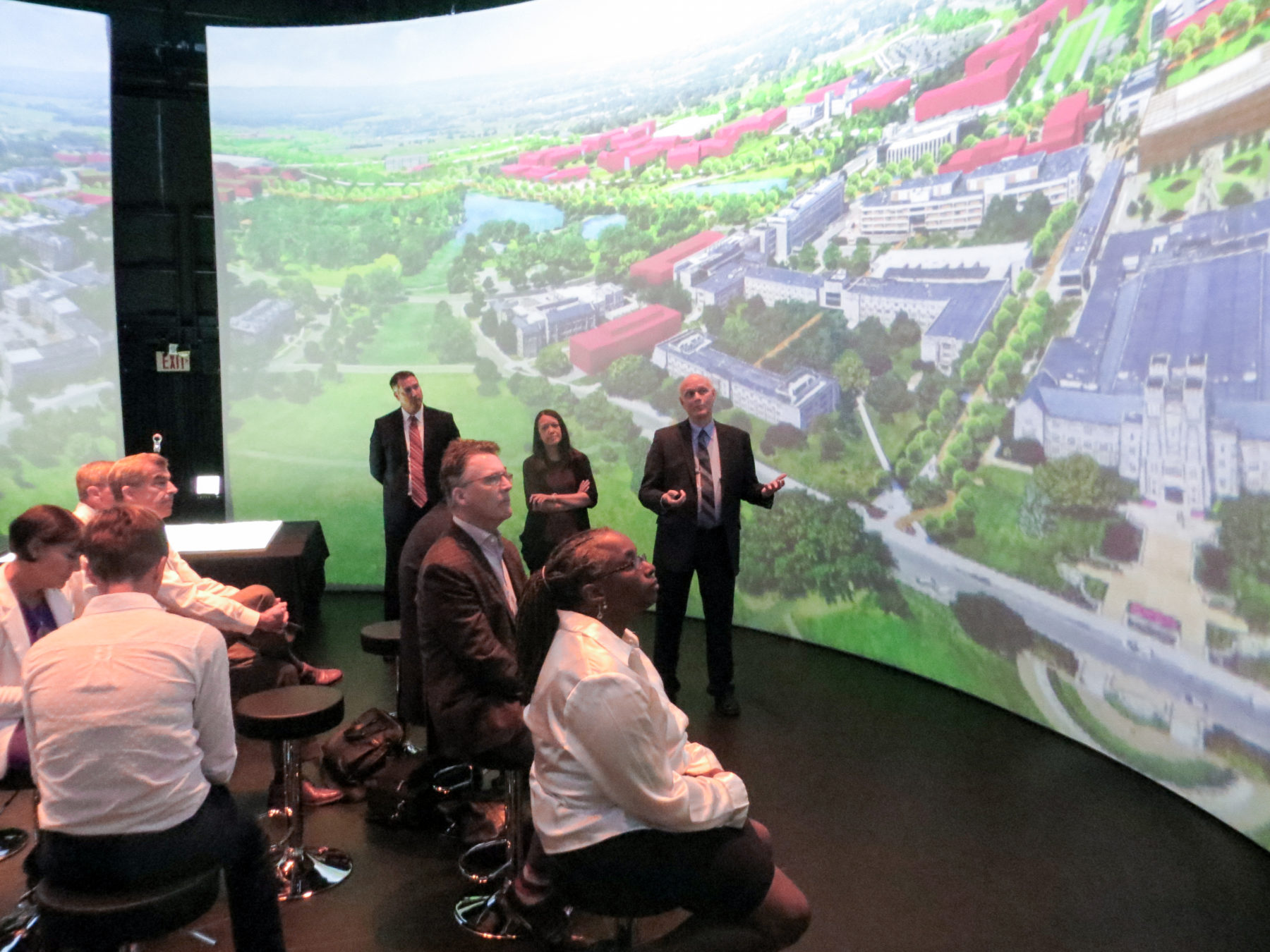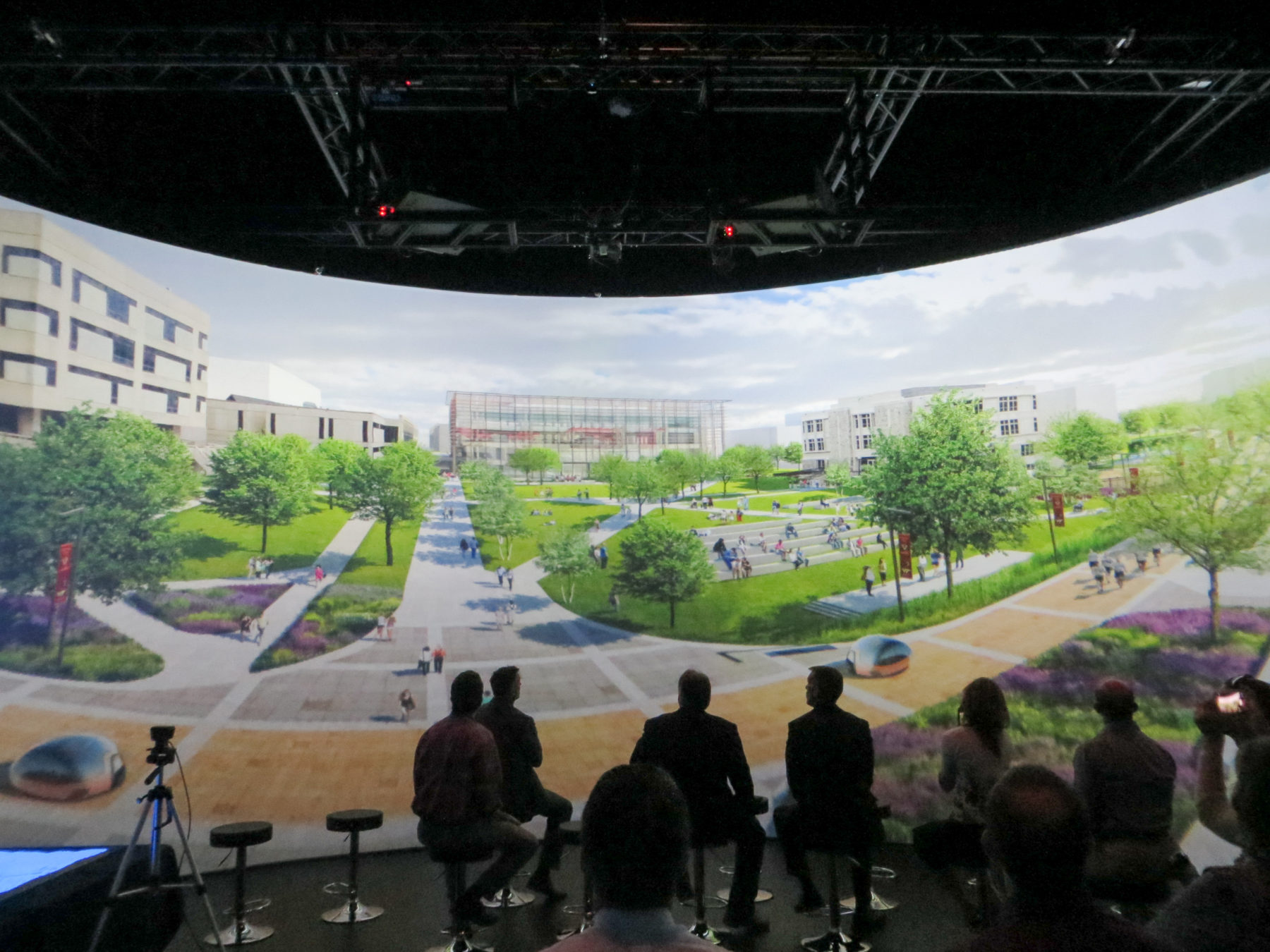Fully Immersive Presentations at Virginia Tech

 Sasaki
Sasaki

Sasaki principal Greg Havens, AIA, AICP dazzled his clients when he finished working on the 1992-1993 Virginia Tech (VT) plan—which made room for VT’s now-iconic reading room arch. It had been printed on a color laser printer out of Sasaki’s own offices. “At that time, this was a big deal!” Havens recalls with a chuckle.
Now, jumping to 2017, Havens finds himself in a similar situation—though this time he leaves the fancy laser-printed report at home, favoring a fully-immersive presentation in the round on a 16’x40’, 360-degree wraparound screen. It is indisputably dazzling. The Sasaki team arrived at VT’s campus this fall to present new plans for VT’s next 30 years. Thirty administrators were invited into the experience to tour a whole new future—in the use of technology and in the future of the school. And the rest of the community was invited to tune into a livestream to take part in the experience from afar.
His clients were impressed by Sasaki’s in-house technology, which was leading-edge at the time. Since then, VT’s beloved arch was built, the campus transformed, and all manner of technology continued to evolve.

Sasaki principals Greg Havens and Mary Anne Ocampo, present the vision for the future of Virginia Tech’s campus in a future-forward, tech-enabled environment
The technology itself presents an opportunity for advancing beyond the single-console virtual reality experience most widely available today. The lead developer of the technical software created for this presentation, principal and director of Data and Design Tools, Ken Goulding, was particularly excited to explore the possibilities of this hyper-custom presentation approach. “This experiment demonstrated the power of immersive environments when the experience is shared. The limitation of virtual reality today, is that it’s almost always a solo experience. You alone can see and interact with what’s in front of you. With the Cyclorama, VT presented us with the opportunity to simulate a fully immersive shared experience where we could bring thirty people into one space to participate in dialogue in real-time.”

Existing conditions shown at large scale

Sasaki designers explain visions of what a space could become
And it was not all special effects tap-dancing. “We did just the opposite,” Sasaki planner and senior associate Chawoo Kim explains. “We thought through how the tool would enhance the storytelling of the plan instead of trying to max out the technology’s potential uses. That’s how we kept it from becoming a dizzying distraction. It had to always remain useful.”
To get inside the audience experience as the team developed this first-of-its-kind presentation, they even built a virtual model of the display space so they could visit the presentation space and spot potential pitfalls. One might call it “VR of a VR,” which is “totally meta” to think about, Goulding explains. Once again, building the simulation of the simulation was not just a lark. The ability to enter the presentation space revealed key problem areas, like the fact that text on the bottom edge of the screen may work for powerpoint presentations on the small-screen but gets lost amongst one’s feet when presenting at full-room scale.

The Virginia Tech campus was rendered in a full 360-degree format for display within the presentation customized for the 180-degree Cyclorama screen. Shown as a static two-dimensional image, the campus is distorted, but in a wraparound environment viewers experience the campus as if standing within its central drill field.
The Sasaki team and a team of rendering partners at Design Distill also learned that creating plan renderings for an immersive experience requires significantly more work. Beyond just a single straight-on view, there are wraparound views to render. And, depending on the narrative, the team made careful decisions about which portions of a rendering to prioritize and which areas to allude to in less detailed form. “These are the kinds of lessons you only learn by doing. That’s the joy of this experiment,” says Kim. In the end, Design Distill developed seven views, using a new technique combining Google Earth views and Sketchup.
For Havens, this project was the perfect confluence of factors. Virginia Tech had the technology just waiting for the right application. Sasaki had the multidisciplinary team hungry to experiment in new modes of immersive storytelling and visualization. The campus itself was particularly well-suited, as it has a central open space, known as the Drillfield, from which the team could orient the entire surrounding campus to convincing effect. “We’ve come a long way since the laser-jet report. I’m just excited to imagine what our presentations might look like in another 25 years!”
Havens gave the immersive presentation once again to the VT board of trustees just last week.
For more information about virtual reality experimentation at Sasaki, click here.
Sasaki team: Greg Havens, Mary Anne Ocampo, Luke Mich, Chanwoo Kim, Ian Scherling, Shiyao Liu, Jonathan Greer, Ken Goulding, David Morgan